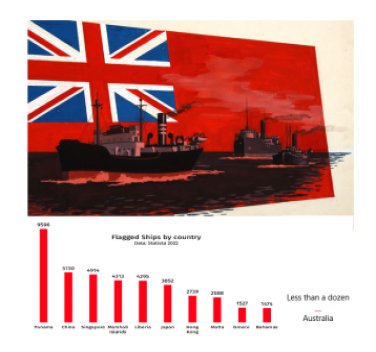In November, the government released a very important document for Australia’s maritime security. The final report of the Strategic Fleet taskforce was handed to government in June, with a public version along with the government response now online.
The taskforce was established as part of a Labor election commitment, with the mission of advising government on how best to establish a fleet of up to 12 Australian flagged and crewed merchant vessels.
The idea Australia should have its own locally flagged shipping fleet is a long-term Labor idea. Bill Shorten endorsed it while he was Labor leader and Anthony Albanese has promised to follow it through.
Australia has only a dozen merchant vessels sailing under the national flag. But the prospect of a national locally flagged shipping fleet has political interest.
The role of supply chains has never been more visible, and more political than it is at present. Any supply chains that were not disrupted by the pandemic or the war in Ukraine, are about to be disrupted by events in the Red Sea. Security is uppermost in everyone’s mind.
The government’s plan is for a fleet of 12 vessels – domestically owned, registered and crewed – to “help Australia build resilience to freight disruptions, while supporting [its] maritime workforce and sovereign capability”.
The taskforce report makes 16 recommendations. The majority of these are relatively minor, focusing on reviewing elements of regulation and legislation, establishing cadetships and improving coordination between existing bodies. It does, however, make substantial recommendations regarding the make-up of this proposed strategic fleet, with taxation reforms to incentivise Australian flagging, a levy on vessel arrivals to help pay for the new fleet, and visa changes to encourage migration.
But to make Australian shipping competitive, key tax and skills issues needed to be addressed, particularly removing income tax for domestic seafarers and expanding existing corporate tax incentives. The taxation and regulatory frameworks mean that it is largely uneconomical to register ships in Australia. Similarly, cost and regulation are currently adding further burdens to the already difficult task of attracting Australians into maritime focused careers.
In 2012, the then Labor government introduced an exemption for certain income generated from shipping activities to bring Australia in line with other jurisdictions; however, tax is still paid on profit distributions.
The response from industry has been negative, with liner lobby group Shipping Australia (SAL) describing the taskforce’s proposals as “bad policy.” The International Transport Workers’ Federation (ITF), on the other hand, has condemned SAL’s opposition to the plan. They claimed SAL was more motivated by maximising profits for the multinational shipping companies it represents than the potential benefits to the Australian economy.
On Mr Albanese’s website he has been quoted as saying, “In times of conflict and crisis, our economic sovereignty and national security are dependent on Australian seafarers working on Australian ships.”
He has also said, “An Albanese Labor Government will strengthen Australia’s economic sovereignty and national security by building an independent Strategic Fleet to secure our ongoing access to fuel supplies and other essential imports.”
Having your own flagged fleet provides just a modest form of insurance. It solves a narrow problem: a scenario where shipping is sufficiently disrupted enough that private ships won’t come to Australia, but not so disrupted that nationalised ships can’t make it. But in an era when governments care a lot about the cost of living, it is highly unlikely they will adopt a policy that risks pushing up shipping costs.
About 40% the world’s commercial ships (by tonnage) are registered in just three countries: Panama, Liberia and Marshall Islands. These and other so-called Flags of Convenience countries attract registrations by foreign ship owners looking to avoid the costs of more stringent regulations and tax regimes in their home countries.
While the shipping flags might be a grab-bag of tiny nations, the shipping lines are not. The three biggest containership operators in the world are the Swiss-owned MSC, Denmark’s Maersk and the French CMA CGM. These are allies or neutral nations.
Their vessels run under a diversity of flags — some Danish, some from the tiny Marshall Islands, some under the flag of Liberia, etc. But the whole point of flags of convenience is that the nation which bestows the flag makes little demand on the ship after the initial payment.
One of the key points of the taskforce report was that Australia’s Coastal Trading Act of 2012 should be reviewed, to “support the implementation of the strategic fleet”, leaving questions over the current situation whereby non-Australian vessels – which means most containerships operating in Australian waters – are awarded temporary licences to carry domestic cargo between Australian ports.
The taskforce clearly believes that the government is being insufficiently ambitious. The report states it felt it necessary to give the government advice “beyond the original intent of establishing a fleet of up to 12” ships. It noted that the 12 should be “the start of what is hoped to be a fleet that will grow to be in the order of 30–50 in number, sufficient to provide a sustainable pool of capability”.
Also see our recent article: Red Sea & Suez: Next Supply Chain Crisis?
As licensed Customs Brokers and International Freight Forwarders, Colless Young professionally handles all your international transport needs. We provide import and export shipping, as well as airfreight, including customs and quarantine clearance, fumigation treatment, warehousing and trucking. We are based in Brisbane and offer a complete range of logistics services through all Australian ports and airports.

